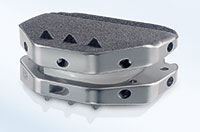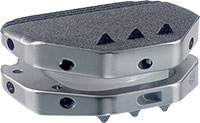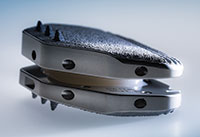 Artificial Disc for the Low Back
Artificial Disc for the Low Back
The concept of the Artificial Disc is to provide an option to spinal fusion surgery. Each year in the U.S., more than 200,000 spinal fusion surgeries are performed to relieve excruciating pain caused by damaged discs in the low back and neck areas.
 During a fusion procedure, the damaged disc is typically replaced with bone from a patient’s hip or from a bone bank. Fusion surgery causes two vertebrae to become locked in place, putting additional stress on discs above and below the fusion site, which restricts movement and can lead to further disc herniation with the discs above and below the degenerated disc.
During a fusion procedure, the damaged disc is typically replaced with bone from a patient’s hip or from a bone bank. Fusion surgery causes two vertebrae to become locked in place, putting additional stress on discs above and below the fusion site, which restricts movement and can lead to further disc herniation with the discs above and below the degenerated disc.
An artificial disc replacement is intended to duplicate the function level of a normal, healthy disc and retain motion in the spine.
Up to recently, one of the chief concerns about using an artificial disc in the low back (lumbar area) is that the weight of the trunk, along with the twisting stresses placed on an artificial disc could make the implant wear out prematurely.
What makes Active L technology different?
Unlike spinal fusion surgery, activL Artificial Disc relieves pain symptoms while also preserving spinal motion. ActiveL as of early 2017, is currently the only lumbar replacement disc in the United States that allows for translational and rotational movements in the spine. Secondly, the technology provides a range of sizes available to accommodate different body types, including a height of 8.5 mm — the lowest available on the market and the optimal size chosen by spine surgeons for 87% of patients in the disc's clinical trial.
 In the clinical trial, patients implanted with activL Artificial Disc were 14 percent more likely to succeed at 24 months than patients in the control group (implanted with other artificial discs), due largely in part to the range of motion outcomes, according to Aesculap Implant Systems, the disc designer. At a six-week follow-up appointment, activL Artificial Disc clinical study patients saw more than a threefold decrease in back pain. This decrease persisted for the duration of the two-year study. The activL Artificial Disc subjects returned to work 29 days sooner than those in the control group. Range of motion success was greater in the activL group (70 percent) compared to the control group (52 percent).
In the clinical trial, patients implanted with activL Artificial Disc were 14 percent more likely to succeed at 24 months than patients in the control group (implanted with other artificial discs), due largely in part to the range of motion outcomes, according to Aesculap Implant Systems, the disc designer. At a six-week follow-up appointment, activL Artificial Disc clinical study patients saw more than a threefold decrease in back pain. This decrease persisted for the duration of the two-year study. The activL Artificial Disc subjects returned to work 29 days sooner than those in the control group. Range of motion success was greater in the activL group (70 percent) compared to the control group (52 percent).
Surgeons are more optimistic about this particular lumbar disc because of the construction of the disc and ability to withstand the stress of a lumbar disc. According to Aesculap Implant Systems, the activL Artificial Disc is the first lumbar total disc replacement with a mobile ultra high molecular weight polyethylene core. The disc consists of two metal endplates with a plastic insert between them. It has a proprietary Plasmapore® titanium coating with a rough calcium phosphate finish that spurs bone growth and improves implant stability.
 As of end of 2016, more than 250 activL Artificial Disc surgeries have been performed in the U.S. Many people are surprised to learn that other countries are able to access new technology faster than the medical community is able to in the United States. For example, about 8,000 activeL surgeries were performed outside the U.S. over the last 10 years.
As of end of 2016, more than 250 activL Artificial Disc surgeries have been performed in the U.S. Many people are surprised to learn that other countries are able to access new technology faster than the medical community is able to in the United States. For example, about 8,000 activeL surgeries were performed outside the U.S. over the last 10 years.
As of early 2017, about 100 surgeons in U.S. are trained and certified to implant activL Artificial Disc based on FDA parameters.
